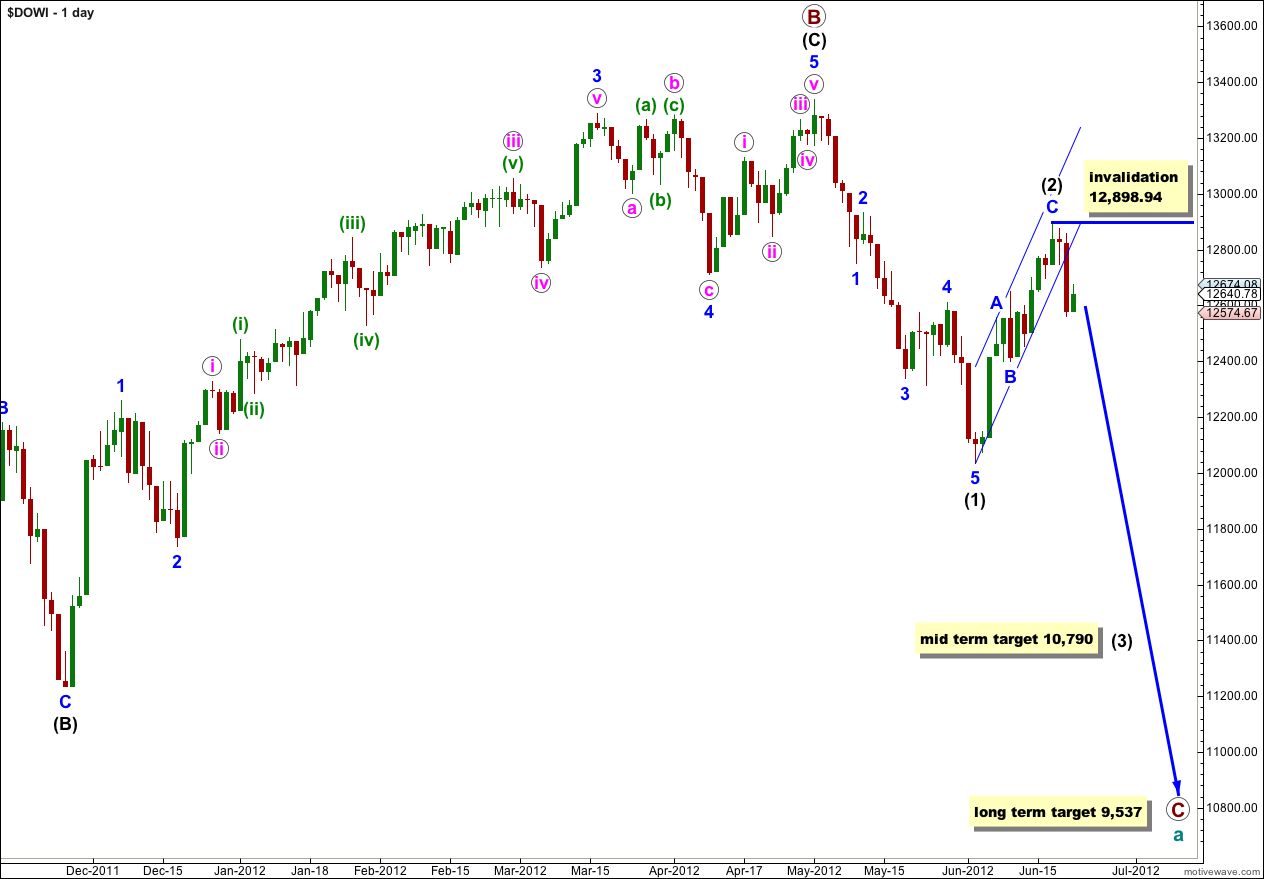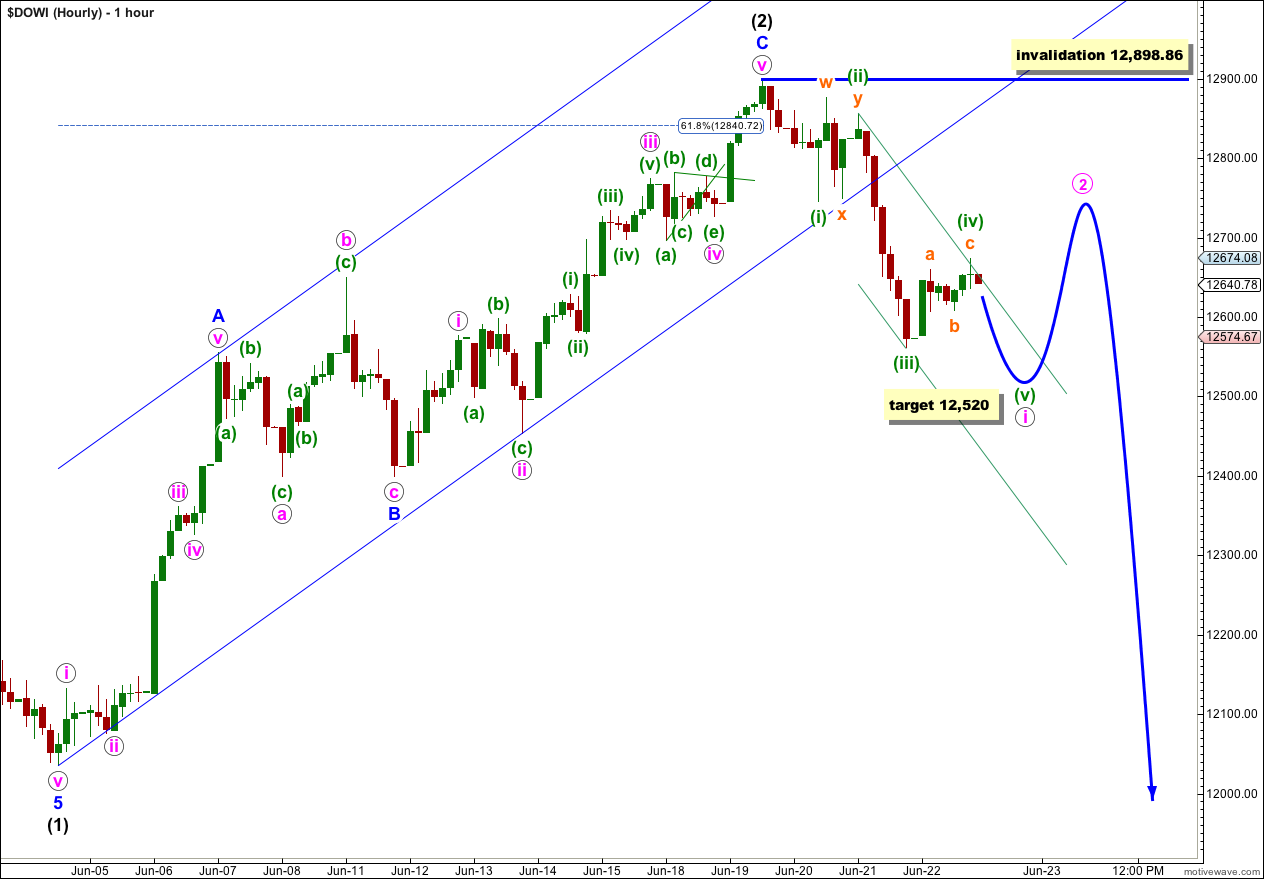Last week’s analysis expected upwards movement from the Dow to a target of 12,918. Price began the week by moving higher to reach 19.14 points below the target before turning downwards.
Thereafter, analysis expected price to turn downwards. We were looking for a trend channel breach on the hourly chart to confirm a trend change.
Click on the charts below to enlarge.
To end the trading week we have a very clear trend channel breach of the parallel channel drawn as a best fit about wave (2) black. We may now expect the upwards zigzag correction is complete and the next wave down has begun.
If we moved the degree of labeling within wave (2) black down one degree we would have an alternate wave count which sees only the first structure in a double complete. Such an alternate would expect wave (2) black is not over and would continue further sideways and higher as a double zigzag or double combination. We would be expecting a three wave structure downwards for an X wave, most likely to be a zigzag. For this reason the main wave count above still requires a five down to be clearly seen to confirm that downwards movement is a third wave, and not an X wave.
Cycle wave a is an expanded flat because primary wave B within it is over 105% the length of primary wave A. An expanded flat expects a C wave to move substantially beyond the end of the A wave. At 9,537 primary wave C would achieve this and would be a typical 1.618 the length of primary wave A.
So far we have a very clear trend channel breach indicating a trend change. We do not yet have a clear five down on the hourly chart which is required to confirm the main wave count.
Wave (2) black ended with a fourth wave triangle for iv pink and a short fifth wave for v pink.
Ratios within wave C blue are: wave iii pink has no Fibonacci ratio to wave i pink, and wave v pink is just 5.42 points short of equality with wave i pink.
Wave C blue is 19.72 points short of equality with wave A blue. As wave C blue is 500.23 points in length this is an acceptable variation (less than 10%).
Within downwards movement we do not yet have a clear five down, but we do have a clear channel breach. So far it looks like three down, which may develop into a five if we see one more wave down. There is no Fibonacci ratio between waves (i) and (iii) green so it is more than likely we shall see a Fibonacci ratio between wave (v) green and either of (i) or (iii) green. At 12,520 wave (v) green would reach equality in length with wave (i) green. This would complete wave i pink downwards.
Thereafter, we should expect a second wave correction. It does not have to be a deep correction but second waves do have a tendency to be deep. When wave i pink is complete draw a Fibonacci retracement along its length. The 0.618 Fibonacci ratio would be the preferred target area for wave ii pink to end.
Wave ii pink may not move beyond the start of wave i pink. This wave count is invalidated with movement above 12,898.86.
Alternate Daily Wave Count.
If we move the degree of labeling within wave (2) black down one degree we have an alternate wave count which sees only the first structure in a double complete. This alternate expects wave (2) black is not over and will continue further sideways and higher as a double zigzag or double combination.
We would be expecting a three wave structure downwards for an X wave, most likely to be a zigzag.
Wave X blue may make a new low below the start of wave W blue so there can be no downwards invalidation point for this wave count. We have to pay careful attention to structure. However, it is unlikely that wave X blue would move below 12,035.09, the start of wave W blue.
Wave (2) black may not move beyond the start of wave (1) black. This wave count is invalidated with movement above 13,339.86.
I think we must seriously consider this alternate because of the brevity of the intermediate degree correction of (2) black on the daily chart, which is only 11 days in duration, when compared to the impulse of wave (1) black which lasted 23 days.



